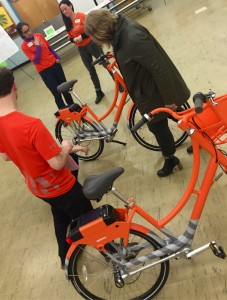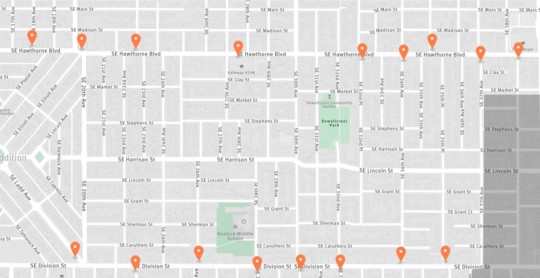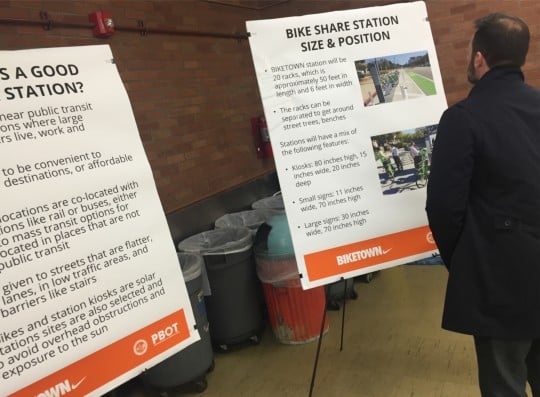The biggest thing to keep an eye one when it comes to Portland’s bike share system isn’t where the stations might go, it’s where they might not go. That’s one of the things I learned at the first open house for Biketown, the Nike-sponsored bike share system the Portland Bureau of Transportation is set to roll out about four months from now.
Last night’s event was one of five open houses that will take place between now and April 7th. PBOT will use them to solicit feedback for where to locate the system’s docking stations. As we reported earlier this month, the city has come up with 300 candidate station locations and they need to whittle that number down to 100.
The 300 proposed sites were chosen by a planning consultant hired by PBOT who worked with a technical advisory committee. They used a combination of factors to make their decisions including things like: access to transit, bike traffic demand, proximity to affordable housing and major destinations, and so on. The stations themselves will have 20 racks, be about 50 feet long and six feet wide.
With that as a backdrop, here’s what I took away from the open house last night…
People are chomping at the bit for bike share
Since PBOT launched their interactive map and asked people to suggest station locations seven days ago, there have been over 3,655 suggestions. That’s a lot of feedback. This demonstrates pent-up demand and interest in bike share — which isn’t surprising given that we’ve been waiting nearly a decade for a system to launch. And last night, even though there weren’t a lot of people at the event (unfortunate conflict with big meetings on air quality and school boundaries), everyone was engaged and filling out comment cards.
Where stations are proposed
The maps shown at the open house were much easier to read than the online one. After staring at each of them (there was a separate map for northwest, southwest, north/northeast, northwest and southeast quadrants), I started to see some interesting trends.
PBOT has proposed multiple stations on many streets where people don’t ride. Streets like NW Lovejoy, SE Division, N Mississippi, SE Hawthorne, SE/NE Grand, NW Lovejoy and NW 23rd are filled with destinations but people tend to avoid riding on because they don’t feel safe or welcoming. What will happen when someone grabs a bike from one of the stations on Hawthorne and then rolls into the street where they have to squeeze between parked cars and a lane shared with people driving cars? Or on Lovejoy which is filled with tire-eating streetcar tracks? Will this result in lots of conflicts or a backlash and/or will it be the big push PBOT is waiting for to gain the political and public will to improve bike access on these streets? When I brought up these questions for PBOT staff at the open house, they didn’t have answers, but they appreciated my feedback.
On the flip side, I was pleased to see so many stations proposed in places that really stand to benefit from bike share: NE Multnomah, especially near Lloyd Center Mall; the Rose Quarter and Moda Center; Portland Community College’s Cascade campus along N Killingsworth; N Williams; the South Park Blocks, and so on.
Another pattern that emerges from PBOT’s candidate locations is where we might end up seeing the new protected bikeways coming as part of the planned Central City Multimodal Safety Project. They’ve proposed multiple stations on SW Stark and Oak, NW Everett, SW Jefferson, and SW 3rd and 4th. Those streets could form part of a future protected bikeway network. No one knows where those bikeways will go, but it’s reasonable to think PBOT might use a similar criteria for them as they’ve used for bike share stations.
Advertisement
Where stations aren’t proposed
And then there are the places conspicuously absent from PBOT’s initial list of station locations. For example, the Central Eastside Industrial District is devoid of stations despite it being a growing center of commerce and a place many people think might be “the next Pearl District.” Turns out the model used to determine good station locations showed that there wouldn’t be a lot of demand in the CEID. It also falls victim to the same rationale PBOT used for not including NE Alberta Street in the service area: a lack of “contiguous density.”
It was also surprising that the downtown transit mall (SW 5th and 6th) and Waterfront Park do not have any proposed stations. Both of these locations would seem to have tons of demand. According to PBOT, they are currently meeting with the Parks Bureau to hammer out right-of-way issues. Same goes for the transit mall. PBOT says any stations on 5th or 6th have to get special approval from TriMet due to design standards on the mall (recall that TriMet doesn’t even allow PBOT put their blue staple racks on the mall).
What’s next
Once PBOT has collected all the public input, they’ll feed it through their station location planning rubric and scorecard. Then the final 100 locations will ultimately be determined by PBOT Director Leah Treat.
Keep in mind that unlike most PBOT bike projects, the public process for bike share will be very quick. They’ll wrap up these open houses in just a few weeks and then they’ll have to start prepping for the July launch. Stay tuned.
— Jonathan Maus, (503) 706-8804 – jonathan@bikeportland.org
BikePortland can’t survive without subscribers. It’s just $10 per month and you can sign up in a few minutes.







